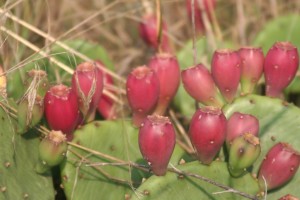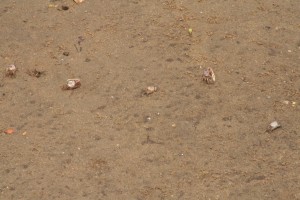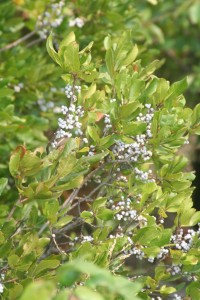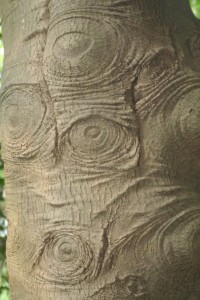 The holly forest at Sandy Hook comprises some 264 acres and is said to include the largest concentration of American Holly on the east coast. I went on a NPS ranger-led walk this afternoon that focused on the ways the Lenape Indians used the natural resources available in the forest and salt marsh to survive. Sandy Hook and much of the mainland in the nearby Highlands was *bought* from the Lenape in 1678. The Lenape had used the area for hunting, fowling, fishing, making canoes, and harvesting food from the natural vegetation. The wild beach plums were one of the main attractions of Sandy Hook for the Lenape and the fruit was collected and dried. The photo above is the fruit of the Prickly Pear Cactus which is widespread on Sandy Hook. The fruit can be harvested (wear gloves to avoid the spiny parts) and made into jellies, dessert sauces, and one company even uses it to make lemonade. In Mexico, the fleshy part of the cactus itself is used in many recipes, including omeletes. The Lenape likely used the dried seeds to produce a product similar to flour. The fruit tastes somewhat like watermelon and is full of tiny seeds.
The holly forest at Sandy Hook comprises some 264 acres and is said to include the largest concentration of American Holly on the east coast. I went on a NPS ranger-led walk this afternoon that focused on the ways the Lenape Indians used the natural resources available in the forest and salt marsh to survive. Sandy Hook and much of the mainland in the nearby Highlands was *bought* from the Lenape in 1678. The Lenape had used the area for hunting, fowling, fishing, making canoes, and harvesting food from the natural vegetation. The wild beach plums were one of the main attractions of Sandy Hook for the Lenape and the fruit was collected and dried. The photo above is the fruit of the Prickly Pear Cactus which is widespread on Sandy Hook. The fruit can be harvested (wear gloves to avoid the spiny parts) and made into jellies, dessert sauces, and one company even uses it to make lemonade. In Mexico, the fleshy part of the cactus itself is used in many recipes, including omeletes. The Lenape likely used the dried seeds to produce a product similar to flour. The fruit tastes somewhat like watermelon and is full of tiny seeds. On our way to the holly forest, walking through the salt marsh, I found these Fiddler’s Crabs at low tide. They scurry about in the sand foraging for food and doing maintenance on their burrows. I wasn’t able to get a close pic, but the males are the ones with the large claws, which they wave around to attract a mate to their burrow. The Fiddler’s plug up their burrows with a ball of mud during high tide, trapping a pocket of air inside, and emerge when the tide recedes.
On our way to the holly forest, walking through the salt marsh, I found these Fiddler’s Crabs at low tide. They scurry about in the sand foraging for food and doing maintenance on their burrows. I wasn’t able to get a close pic, but the males are the ones with the large claws, which they wave around to attract a mate to their burrow. The Fiddler’s plug up their burrows with a ball of mud during high tide, trapping a pocket of air inside, and emerge when the tide recedes. Northerh bayberry, typical of coastal habitats. The tiny berries are a food source for swallows and catbirds (I’ve read that Rails eat them also) and are also used in candlemaking.
Northerh bayberry, typical of coastal habitats. The tiny berries are a food source for swallows and catbirds (I’ve read that Rails eat them also) and are also used in candlemaking. Some of the hollies at Sandy Hook are thought to be as much as 170 years old. This tree was large, but was not the oldest among them. I loved the knobby look of the trunk. Today’s walk was too short and quick for my liking, but it was nice to see this part of the holly forest. The area is normally closed to the public as it’s part of a large wildlife management area. I didn’t see any osprey or terns today, and the platform in the marsh was occupied by a greater black-backed gull when we walked past it. I saw a few migrating monarch butterflies, but the goldenrod isn’t blooming just yet, so I can expect to see many more in the coming weeks.
Some of the hollies at Sandy Hook are thought to be as much as 170 years old. This tree was large, but was not the oldest among them. I loved the knobby look of the trunk. Today’s walk was too short and quick for my liking, but it was nice to see this part of the holly forest. The area is normally closed to the public as it’s part of a large wildlife management area. I didn’t see any osprey or terns today, and the platform in the marsh was occupied by a greater black-backed gull when we walked past it. I saw a few migrating monarch butterflies, but the goldenrod isn’t blooming just yet, so I can expect to see many more in the coming weeks.
17 thoughts on “In the holly forest”
Comments are closed.
That last tree trunk is intriguing. It is reminding me of some pattern, but I can’t quite put my finger on what it is.
Lovely pictures, as usual! I didn’t know you had nopal that far north!
Bunnygirl: You know, I’d been wondering what the “nopales” I see in the grocery store were – I knew they were some type of cactus, but hadn’t realised they were prickly pear until I did a bit of reading for this post. Have you eaten them? I think the type that grows here in the east is different than the type that grows in the desert.
John: Not sure what you’re thinking of, but when I look at it I think of the diamondback terrapin.
I had prickly pear cactus fruit that was pickled in Arizona. It tasted pretty good!
I love the tree trunk pattern!
What an interesting post, and the photos are great,too. I am familar with pricky pear, we had it in the pastures at my parents farm in Oklahoma. Surprised that it grows on the east coast. Also didn’t know that holly grew into large trees. Now, I need to go look up the Lenape Indians!
That tree trunk pattern is beautiful! I have a prickly pear cactus in my garen. It blooms with beautiful yellow flowers every spring, but the fruit never ripen, but instead shrivel up. Any ideas why?
Hey, Laura. I’ve really enjoyed your photographs, which is why I linked to your blog. I also enjoy reading your writing. Thanks for sharing!
Lynn in N.H.
I have added prickly pear cactus to fruit salads, particularly a Vietnamese one I do with several kinds of citrus fruit, pineapple, banana, apple, pear, red bell pepper, and a lemon juice, sugar, and chili sauce dressing. The cactus doesn’t have a lot of taste, but the color makes the whole thing very pretty. But, I can never get the prickly pear here in Alaska, so I have had to do without it these last years.
Another great post! Thanks!
Even though I know they’re up here, I’m always always surprised to see cactus in the Northeast. Also, hollies are so common as ornamentals, but so much less common as wild trees, it’s easy to forget they’re native.
Prickly pear in NJ?
Who da thunk?
I agree, definitely diamondback terrapin pattern.
Naturewoman: Hard to describe the flavor, isn’t it?
Sandy: Treasure trove of mostly-useless info, I am. The history of the Lenape has been drilled into my head going to school in the area.
Lynne: I missed the flowers this year – for some reason I think these bloom in July. I don’t know why the fruit would shrivel up? Too cold maybe?
Maya’s granny: Do you add the fruit or the flesh of the cactus to your salad? If it’s the cactus itself, you might look in the Spanish food section – canned or jarred Nopales – might be in a brine, though. Just a thought.
Mojoman: I’m so used to seeing them at the beach that when I come across them anywhere else I’m surprised to find them.
Susan: I think some form of prickly pear grows everywhere.
FC: Thanks for stopping by! I was looking at your prickly pear post from Sept. 2005 earlier today and wondering at how different the Florida species looks.
There are diamondback terrapins at Sandy Hook – the ranger had a carapice that he showed us during the walk that day – maybe that’s why this holly trunk reminded me of them.
Thanks for giving us a tour too, Laura. I didn’t realize that cacti lived in NJ. The tree trunk is really interesting looking.
Sounds like a wonderful place, thanks for the tour!
welcome to the wow power leveling cheap wow power leveling service site,WoW Gold buy cheap wow gold,wotlk gold,world of warcraft power leveling buy wow gold
I am grateful to you for this great content.aöf thanks radyo dinle cool hikaye very nice ssk only cinsellik very nice ehliyet only home free kadın last go korku jomax med olsaoy hikaye lesto go müzik dinle free only film izle love aşk only mp3 indir only radyolar lest go açıköğretim free net only filmler
Welcome to FinerReplica.com! We look forward to give you an insight of the very best quality replica handbags.We wholesale replica handbags, Cheap designer handbags,Coach, Burberry, Jimmy, Prada, LV, GUCCI Handbags, Juicy Handbags and so on. We are proud to advise you about the best online replica handbags shops in the world. Why shouldn’t every woman have the right to shine while walking along the street with her Gucci, Louis Vuitton or Chanel? We believe that every woman deserves the right to look and feel fabulous, and we fulfill this belief by bringing you sites with the highest quality handbag replicas at a price that suits every budget.
If you are to buy cheap designer handbags at wholesale price, feel free to browse our designer replica handbags that are virtually indistinguishable from the authentic ones. Then,come to buy designer replica handbags now!